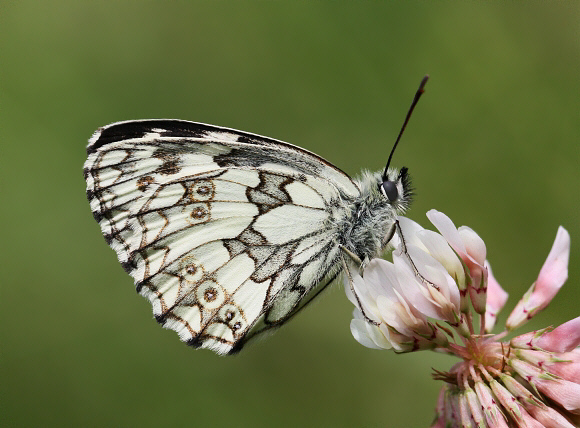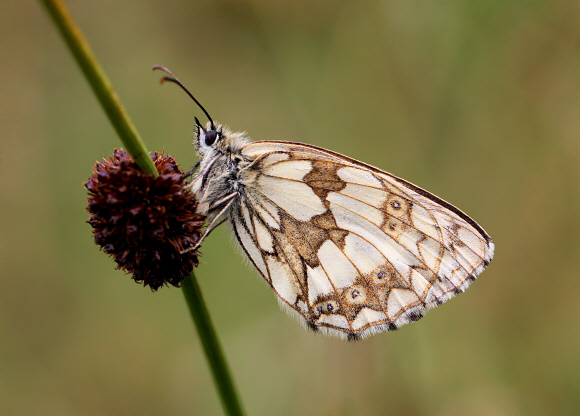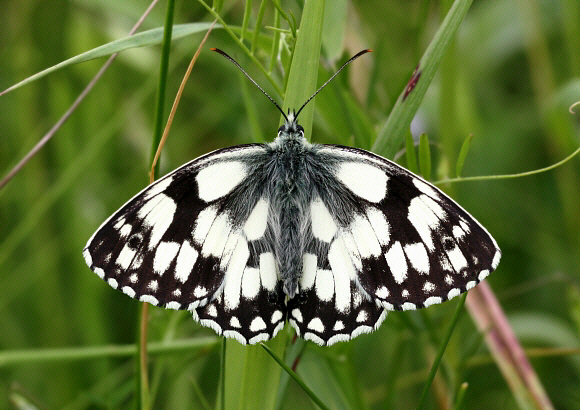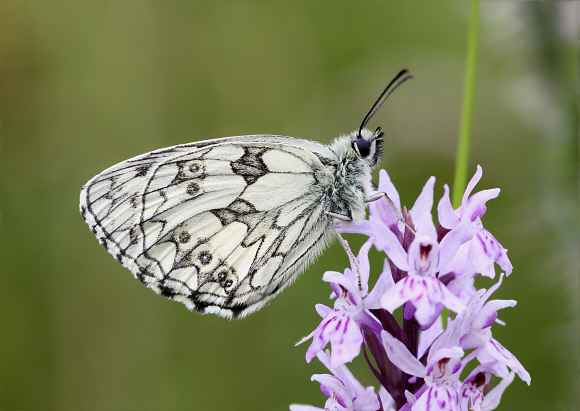
Introduction
There are 24 species in the genus Melanargia, known commonly as the Marbled Whites. The genus is readily recognised by the black-on-white marbled uppersides and the series of submarginal ocelli on the underside hindwings. Both sexes are similar in pattern but males are a purer white. Females are slightly creamy in appearance especially when freshly emerged, and are marked in dark brown rather than the neutral black of males.
A freshly emerged Marbled White is among the most beautiful of British butterflies. Its distinctive chequered black and white pattern is very different to that of other Satyrines, most of which are patterned in shades of brown and orange. The pattern of the Marbled White is easily remembered by insectivorous birds, and is probably a form of aposematic coloration, functioning to advertise the toxic nature of the butterfly.
The sexes can be distinguished by examining the dark peppered bands on the underside – in the male these are a neutral grey colour, while in the female they are a warm greyish brown. Neither sex is prone to much in the way of variation, although entirely black or entirely white forms are known, but these and intermediate forms are exceptionally rare.

This species is distributed across much of Europe, but is absent from Portugal, most of Spain, most of the Mediterranean islands, and Scandinavia. Beyond Europe it occurs in northern Africa, Turkey, Georgia, Armenia and Azerbaijan.
There are 6 other very similar Melanargia species that occur in Europe with which the butterfly can easily be confused. In the French Pyrenees the butterfly is known to regularly hybridise with the Iberian Marbled White Melanargia lachesis, producing infertile offspring.
Habitats
In Britain this species is confined mainly to southern and south-western counties of England. A few scattered colonies still exist in Yorkshire, south Wales and the Midlands, but the butterfly’s range has contracted considerably, due mainly to loss of habitat.
It breeds primarily on well drained chalk grasslands, typically occurring in huge colonies numbering hundreds or even thousands of individuals. The highest numbers occur on un-grazed or very lightly grazed sites where the grasses grow waist high. Such habitats include cliff-tops, undercliffs, steep south-facing slopes, abandoned quarries and ancient Iron Age hill forts. Smaller colonies numbering a few dozen adults exist in certain woodlands where they breed along unmown grassy avenues or in large clearings or permanent glades.
Although populations are normally very localised, the butterfly has excellent powers of dispersal, and is able to colonise motorway embankments, railway cuttings and similar such wild grassy sites in southern England. I also regularly see singletons wandering across certain New Forest heaths.

Lifecycle
The Marbled White is single brooded throughout it’s range, emerging in late June and throughout July. By early August only a handful remain on the wing at most sites, although at cool windswept coastal grasslands it is often possible to find a few fresh specimens even in mid-August.
Most butterflies attach their eggs to specific plants, but Marbled White females are unusual because they drop their eggs randomly onto the ground as they fly in and out amongst tall grasses. The eggs are globular and whitish. They are laid in July and August, and hatch after about 2-3 weeks. After eating its eggshell and nibbling at fine grasses for a few days, the larva enters hibernation, spending the winter months hidden at the base of grass clumps. It awakens in March and feeds nocturnally on red fescue Festuca rubra and sheep’s fescue Festuca ovina. During the daytime it hides at the base of grass clumps, emerging at dusk to feed on coarser grasses such as cocksfoot Dactylis glomerata, tor grass Brachypodium pinnatum, and timothy Phleum pratense. The mature larva is whitish-brown or yellowish-green, marked with a series of thin dark lines along the back and sides. The head is brown. The pale ochreous or brownish chrysalis is formed on or just below the surface of the soil. The pupal stage lasts about 3 weeks.

Adult behaviour
Marbled Whites emerge at the very beginning of July, and remain on the wing until early August. They fly in a lazy fashion, advertising their presence as they flutter above and between tall grasses. Both sexes nectar for long periods, mainly at knapweeds, thistles, small scabious and bramble, but will also visit hawkbit, ox-eye daisy, hemp agrimony, yarrow, wood spurge and rosebay willowherb.
The sexes mix freely and there does not appear to be any form of ritualised courtship or territorial behaviour. It is likely that females are mated almost immediately after making their maiden flight. Copulated pairs can be found settled amongst grasses or low herbage in late morning, and remain paired for at least half an hour before parting. If disturbed they will fly a short distance, with the female carrying the male in flight. When settled the female tends to partially or fully open her wings, while her partner keep his wings firmly closed.
It is common to find Marbled Whites that have one or more bright red parasitic mites clinging to the thorax, head or abdomen. Studies have shown that these mites Trombidium breei are harmless to the butterfly, having no detectable effect on the flight performance, orientation ability or lifespan. The same species of mite parasitises several other grassland butterflies including Meadow Brown, Gatekeeper, Common Blue, Chalkhill Blue, Adonis Blue and Small Skipper.
Marbled Whites usually feed and rest with wings closed, but on hazy afternoons, or overcast days they can be seen basking with wings open, settled on low herbage or amongst tall grasses. As dusk approaches they move to sheltered areas where they settle on grass-heads or on knapweed, thistle or orchid flowers. They roost in a head-downwards posture, often with several ( usually of the same sex ) sharing the same grass-head.

Marbled White Melanargia galathea Bedwyn meadows, Wiltshire – Adrian Hoskins
